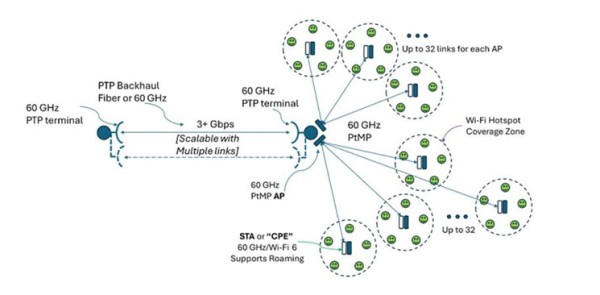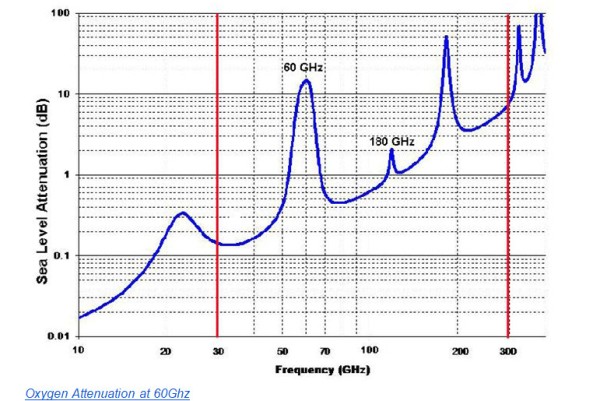Introduction
As high-speed internet access spreads around the world, the unlicensed 60GHz (57-71 Ghz) millimeter-wave (mmWave) spectrum offers immense potential for low-cost, low-capex, easily-deployed high-speed wireless communication, especially areas currently underserved by traditional broadband distribution—fiberoptic. Further, However, until recently, purchasing devices to adequately provide mmWave communications for 60Ghz/mmWave broadband deployments has been difficult. Peraso and several other companies have developed and ramped up mass manufacturing of viable 60Ghz solutions for this market, which is further set to grow as other frequency bands, such as those used by WiFi (2.4 and 5Ghz) and 4G cellular, become more and more saturated and congested.

In contrast, 60Ghz mmWave has almost unlimited potential as it does not penetrate objects extremely well, and it attenuates more, and can be directionalized more effectively using phased arrays. As such, “Fixed 5G,” 60Ghz/mmWave, also referred to as unlicensed V-band, is an excellent option for high-capacity backhaul; for instance, a narrow 60Ghz over-the-air beam instead of fiber optic cable.
Looking at several competing products as potential selections for 60Ghz FWA buildouts in lieu of fiber, Peraso’s PERSPECTUS product line appears to best capitalize on this opportunity, for both dense urban environments and rural areas. Peraso’s technology and products are positioned for success in these distinct contexts.
60Ghz mmWave for Broadband: Feasible, but Difficult
The unlicensed 60Ghz V-band provides abundant bandwidth withthe largest amount of contiguous spectrum available, enabling gigabit-per-second data rates. mmWave was originally envisioned for indoor use only due to line-of-sight constraints and oxygen’s absorption-causing attenuation in the middle of the 57-71Ghz spectrum, right around 60Ghz. While 60GHz signals attenuate rapidly over distance, this limitation can be an asset in certain situations. Short-range, high-speed connections are ideal for applications like home broadband, office networks, and IoT deployments. However, Peraso has out-innovated its peers; its chipsets and integrated modules (containing antenna) enable point-to-point (PtP) distances of up to 20km (~12.5mi). This was done with several engineering efforts, from proprietary advanced beamforming techniques to employing the entire unlicensed V-band (57-71Ghz) to “work around” the oxygen attenuated range. Other suppliers do not use the V-band from 57Ghz all the way up to 71Ghz as it is difficult to produce chips to support the 66-71Ghz band with reliability and low variance—a capacity Peraso has honed with years of experience.

Other challenges with mmWave include line-of-sight challenges. Obstacles can significantly
attenuate signal strength. This includes walls, but also foliage, which may grow and change
shape to interfere with signaling after a fixed wireless link is deployed. Peraso’s products are
designed to handle these in-field practical problems as they have adaptive beamforming, where the technology dynamically adjusts beam direction, compensating for obstacles and maintaining optimized connectivity. Additionally, in dense urban areas, line-of-sight paths are often obstructed before deployment. Peraso’s PERSPECTUS modules mitigate this by exploiting the signal’s reflections and diffractions, ensuring robust connections, even around corners.
Lucrative Applications for 60Ghz mmWave
In both dense urban environments as well as rural areas, oftentimes cost of deploying a network is a limiting factor in bringing broadband online for these communities.
Concerning rural areas, the cost of FWA in an example area has been estimated to be about 10% of the upfront cost and 30% of the total long-term cost compared with fiber in the same area. Other non-rural estimates place the total capex at 50-60% of fiber’s capex, which is still less expensive. One downside of FWA is the higher cost of power compared to fiber; however, Peraso’s units have superior cost and energy performance profiles with low wattage and optimized beamforming, resulting in more efficient power transmission.
With respect to dense urban environments, the 60Ghz value proposition is somewhat different. Of course, cost and performance are always important; however, in dense urban environments, the main proposition is the high data speeds and the lack of interference and congestion that can be accomplished with 60Ghz. Peraso, specifically, has also powered its FWA offering with an internet protocol called DUNE which improves the distribution of data communication to large numbers of users in a congested area, by optimizing the structure of data sent. This dynamic traffic management improves PtMP network capacity by up to almost 50% with low (1-4ms) latency. And Peraso’s up-to-32 user APs, connected to Peraso’s PtMP location, can be backhauled efficiently with Peraso’s PtP solution. In each situation (rural, urban), access points can be added as user demand grows.
60Ghz mmWave: Market Leadership
Peraso recently announced its first purchase order for its DUNE-powered PERSPECTUS solution, whereby the PERSPECTUS modules will be used in conjunction with DUNE to supply mmWave connectivity for informal settlements. FWA leader Ubituiti, along with other FWA suppliers, appears to prefer Peraso’s technology for its FWA solutions, and when looking at PERSPECTUS specifications and roughly comparing to competitors, it is clear why.
|
Company |
Peraso/Ubiquiti |
|
|
Siklu/Ceragon |
|
Ignitenet |
|
|||
|
|
|
|
|
|
|
|
|
|
||
|
|
|
|
|
PtP |
|
|
||||
|
|
|
|
|
|
|
|
|
|||
|
Product |
|
Wave Pro |
|
|
EtherHaul 600/614 |
|
MLTG-CN LR |
|
||
|
|
|
|
|
|
|
|
|
|
|
|
|
Total User Capacity |
|
5.4 Gbps |
|
|
1 Gbps |
|
3.6 Gbps |
|
||
|
|
|
|
|
|
|
|
|
|
|
|
|
Range |
|
15 km |
|
|
2.6 km |
|
|
1 km |
||
|
|
|
|
|
|
|
|
|
|
||
|
Antenna Gain |
46 |
|
|
|
36 dBi |
|
|
40 dBi |
||
|
|
|
|
|
|
|
|
|
|||
|
Frequency Band |
57-71 GHz |
|
|
57-68 GHz |
|
|
57-66 GHz |
|||
|
|
|
|
|
|
|
|
|
|||
|
Power Consumption |
26 W max |
|
|
26 W |
|
|
15.9 W max |
|||
|
|
|
|
|
|
|
|
|
|
|
|
|
|
|
|
|
PtMP |
|
|
|
|
||
|
|
|
|
|
|
|
|
|
|||
|
Product |
|
Wave Pro |
|
|
|
MultiHaul B100 |
|
MLTG-360-1 |
||
|
|
|
|
|
|
|
|
|
|
|
|
|
# STA |
24 |
|
|
8 |
|
15 |
|
|||
|
|
|
|
|
|
|
|
|
|
||
|
Total User Capacity |
|
5.4 Gbps |
|
|
2.3 Gbps |
|
|
3.8 Gbps |
||
|
|
|
|
|
|
|
|
|
|
||
|
Range |
|
8 km |
|
|
400 m |
|
|
300 m |
||
|
|
|
|
|
|
|
|
|
|
||
|
Gain |
|
46 dBi |
|
|
40 dBi |
|
|
28 dBi |
||
|
|
|
|
|
|
|
|
|
|||
|
Frequency Band |
57-71 GHz |
|
|
57-64 GHz |
|
|
57-66 GHz |
|||
|
|
|
|
|
|
|
|
|
|||
|
Power Consumption |
26 W max |
|
|
10 W |
|
|
30 W max |
|||
|
|
|
|
|
|
|
|
|
|||
|
Watts/max STA |
1.08 |
|
|
1.25 |
|
2 |
|
|||
|
|
|
|
|
|
|
|
|
|
|
|
The last thing to note is that specifications are not the end-all-be-all. How well the products work in the field—their practicality and reliability—and the products’ economics are the most important factors for FWA hardware selection. Several 60Ghz competitors have fallen victim to Peraso’s superior competitiveness in the 60Ghz FWA market, and in-field success is likely a big part of that commercial success. While there are other bands available to provide connectivity, as those bands become congested, saturated, or struggle with interference, its likely that more will turn to the interference-free 60Ghz mmWave market as a solution, where Peraso leads, especially with greatly superior PtP (backhaul) and PtMP distances and overall reliability.
Conclusion
Peraso’s PERSPECTUS modules are poised for success in the 60GHz mmWave market. Their adaptability, speed, and versatility make them indispensable for both urban and rural connectivity. Even to non-RF engineers, it should be clear why Peraso is the market leader Ubituiti’s supplier-of-choice for 60Ghz solutions.
Disclaimers: The Private Securities Litigation Reform Act of 1995 provides investors with a safe harbor with regard to forward-looking statements. Any statements that express or involve discussions with respect to predictions, expectations, beliefs, plans, projections, assumptions, objectives, goals, and assumptions about future events or performance are not statements of historical fact and may be forward looking statements. Forward looking statements are based on expectations, estimates, and projections at the time the statements are made that involve a number of risks and uncertainties that could cause actual results or events to differ materially from those presently anticipated. Forward looking statements in this action may be identified through use of words such as projects, foresee, expects, will, anticipates, estimates, believes, understands, or that by statements, indicating certain actions & quotes; may, could or might occur Understand there is no guarantee past performance is indicative of future results. Investing in micro-cap or growth securities is highly speculative and carries an extremely high degree of risk. It is possible that an investor's investment may be lost or due to the speculative nature of the companies profiled. TheStreetReports (TSR) is responsible for the production and distribution of this content."TSR" is not operated by a licensed broker, a dealer, or a registered investment advisor. It should be expressly understood that under no circumstances does any information published herein represent a recommendation to buy or sell a security. "TSR" authors, contributors, or its agents, may be compensated for preparing research, video graphics, podcasts and editorial content. "TSR" has not been compensated to produce content related to "Any Companies" appearing herein. As part of that content, readers, subscribers, and everyone viewing this content are expected to read the full disclaimer in our website.
Media Contact
Company Name: The Street Reports
Contact Person: Editor
Email: Send Email
Country: United States
Website: http://www.thestreetreports.com

